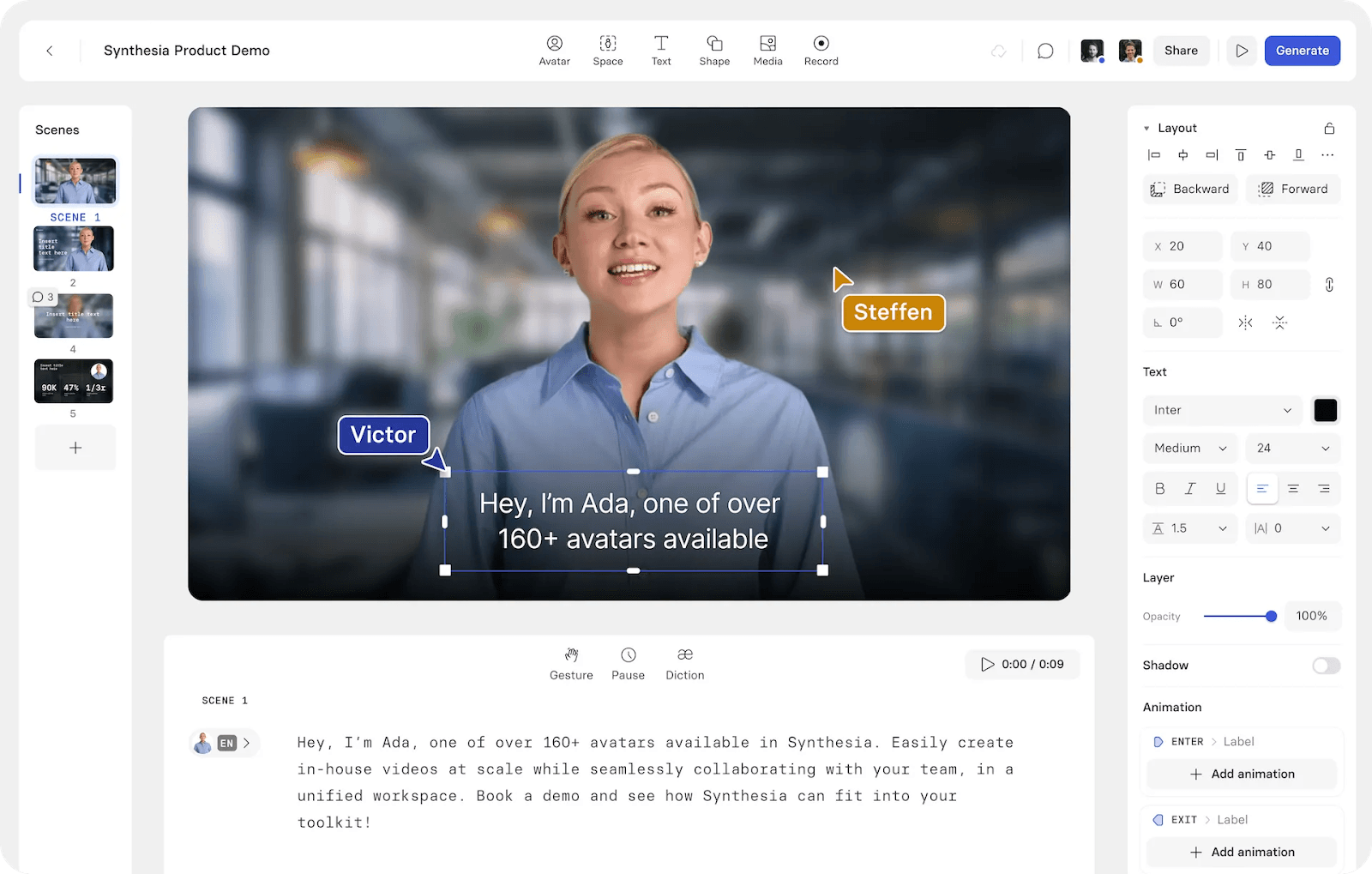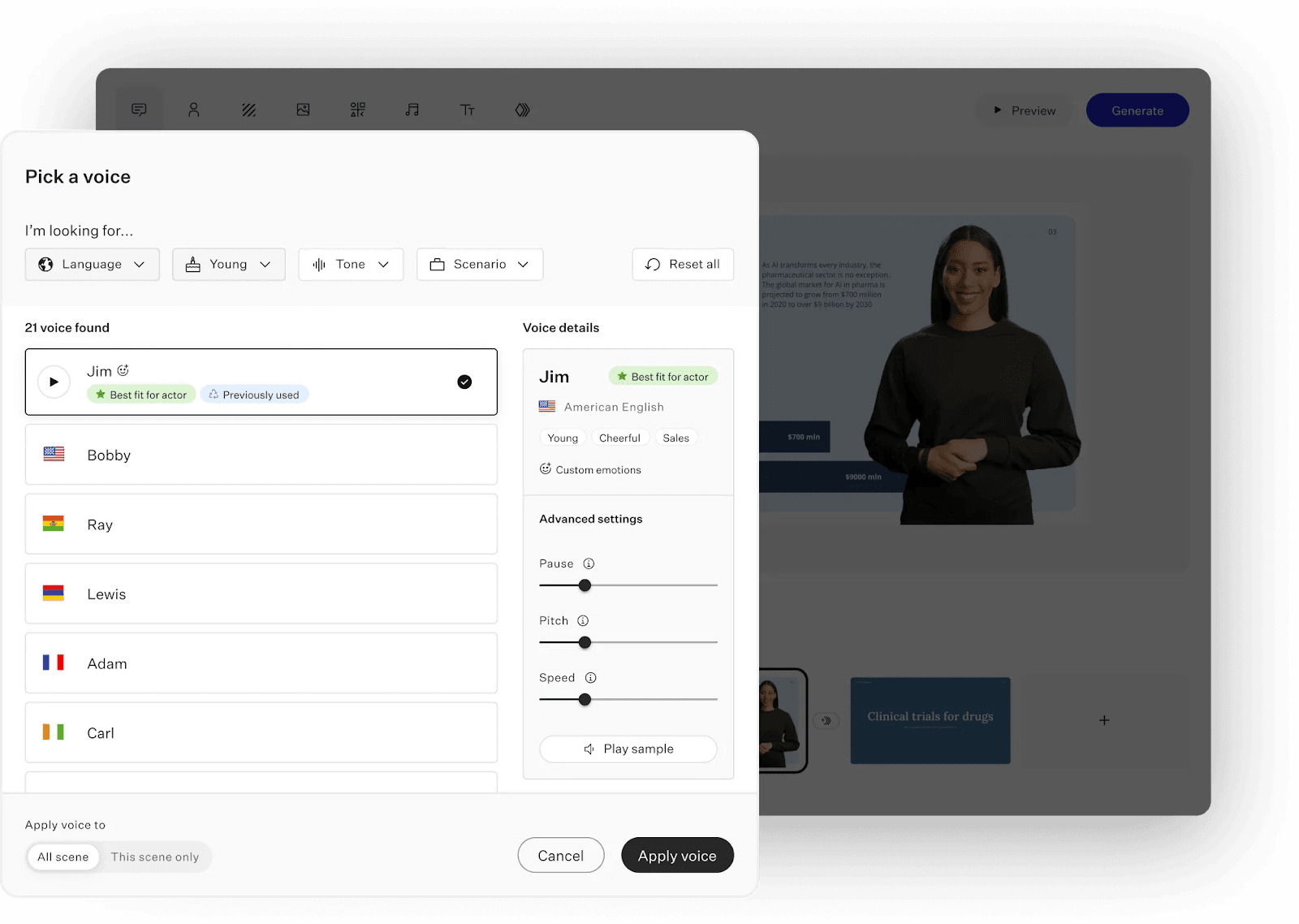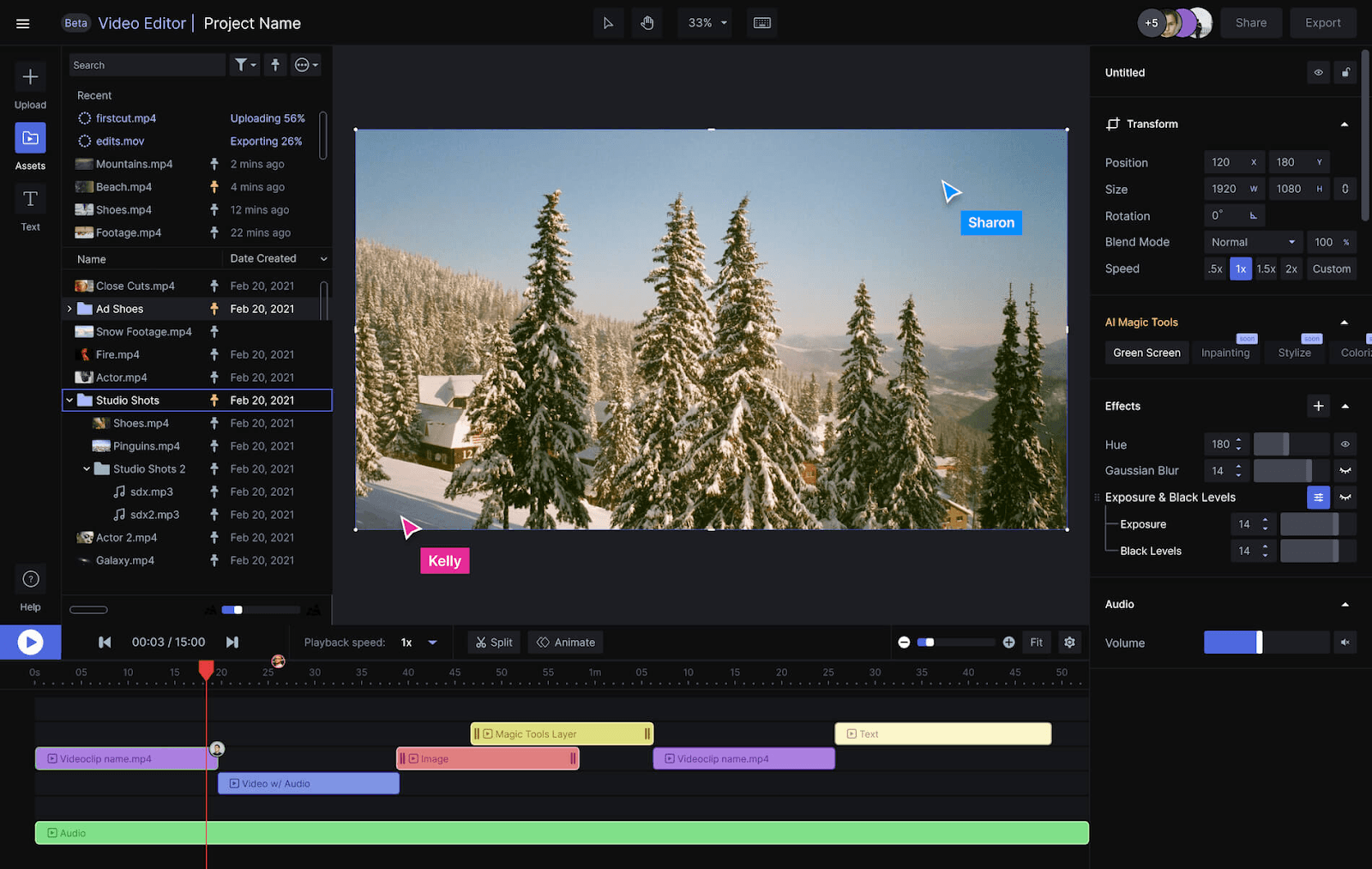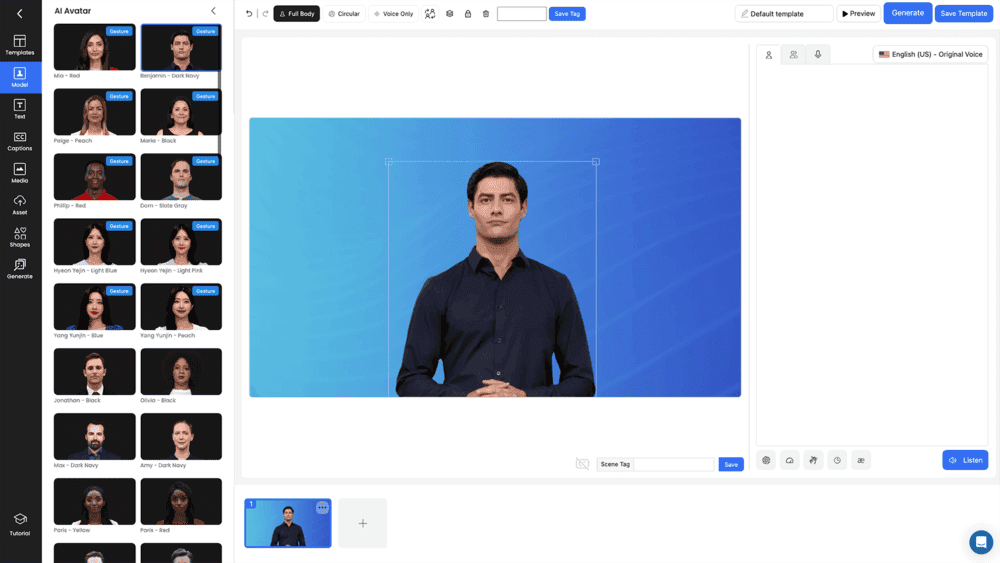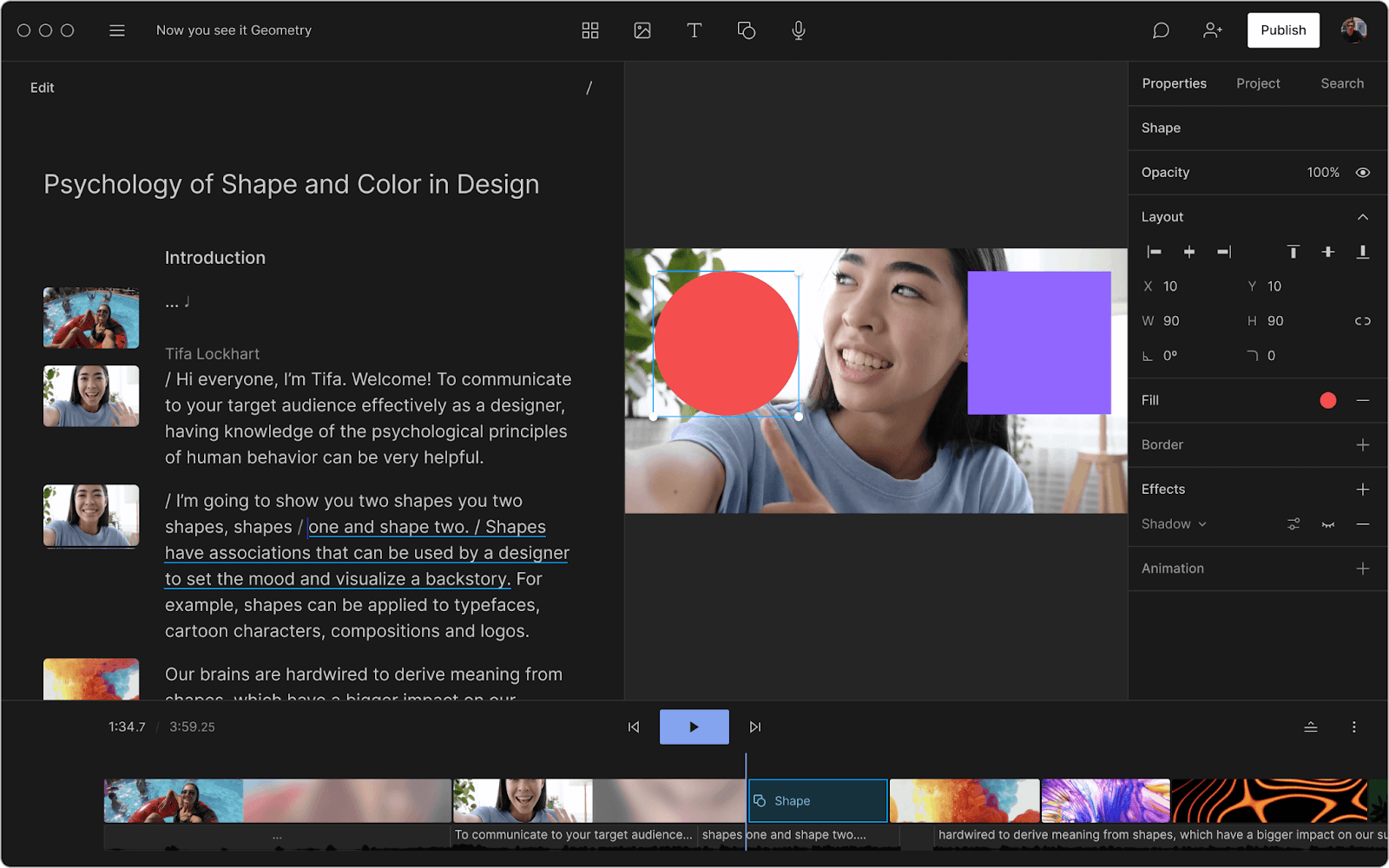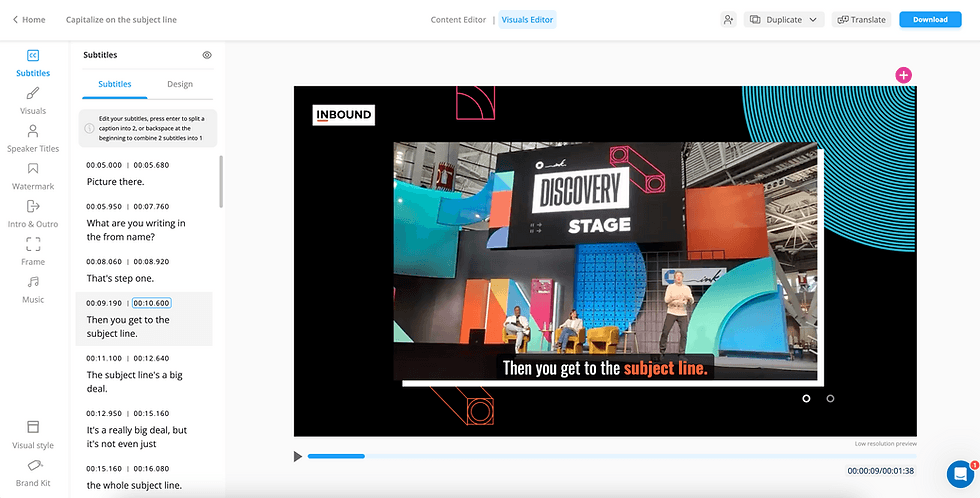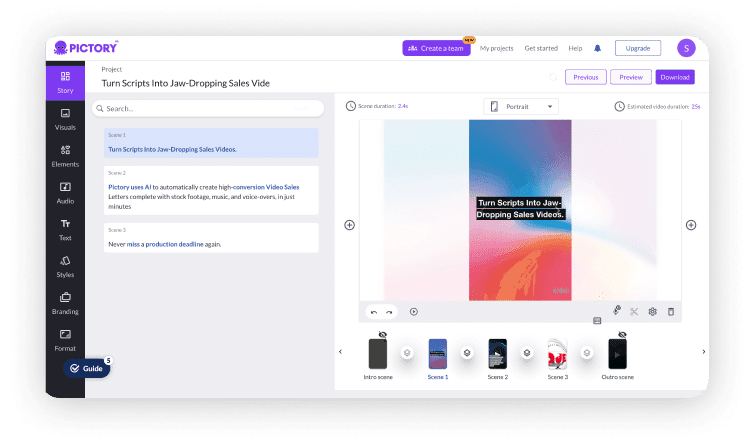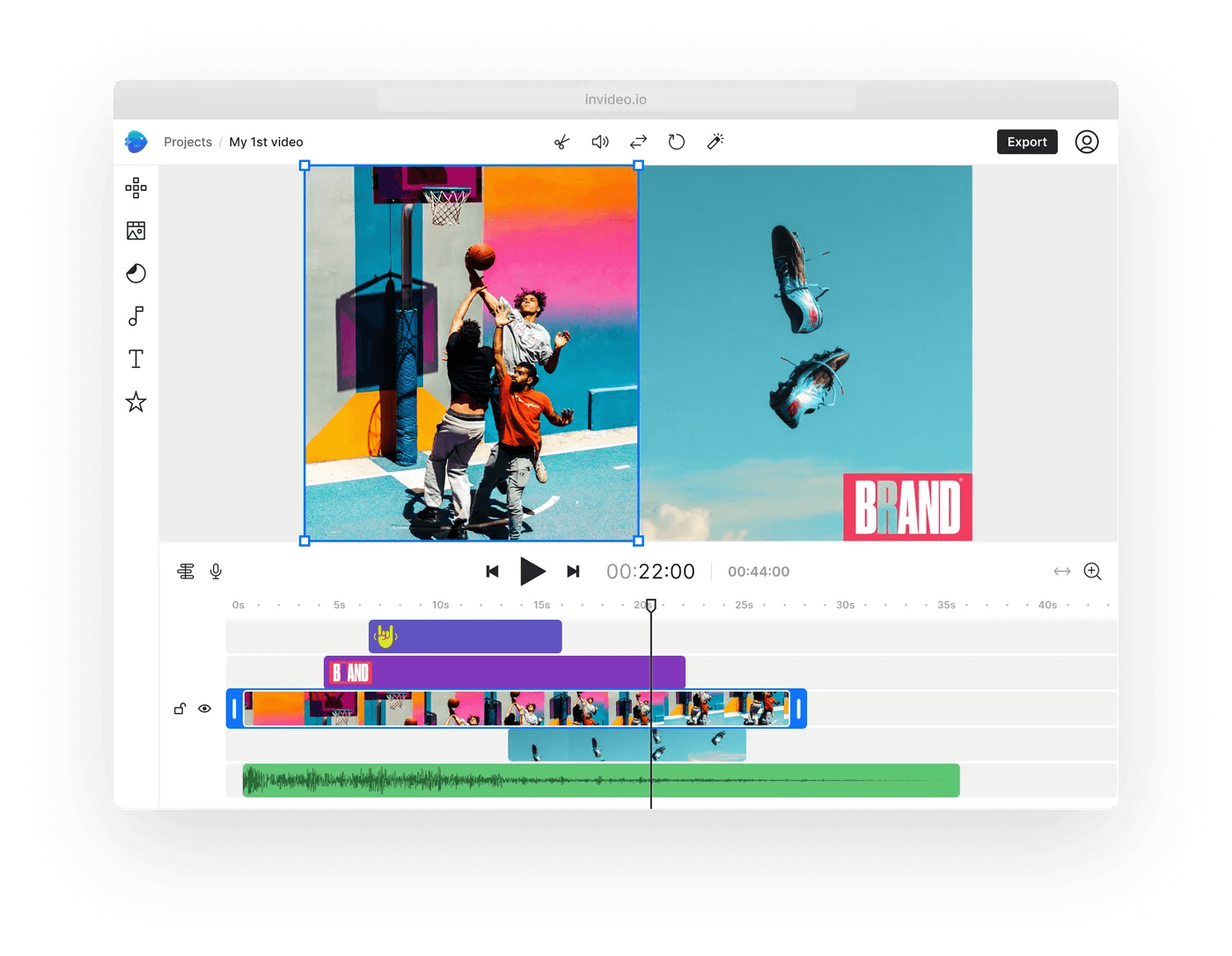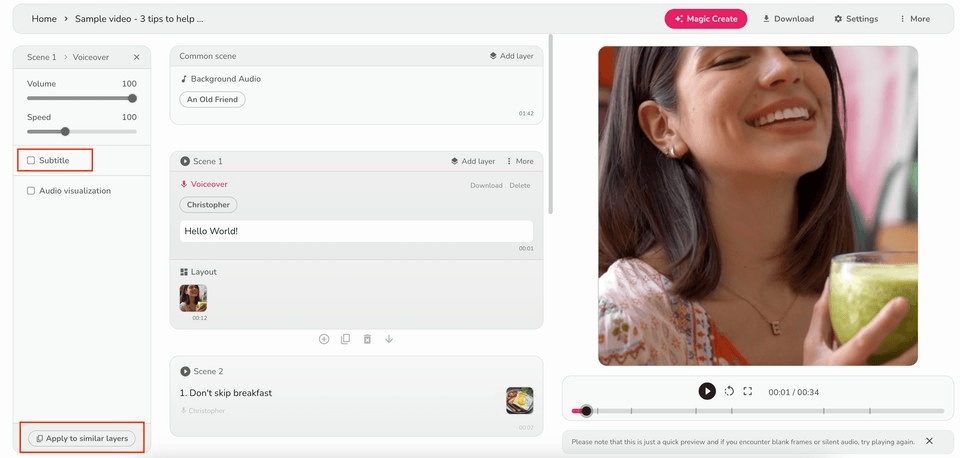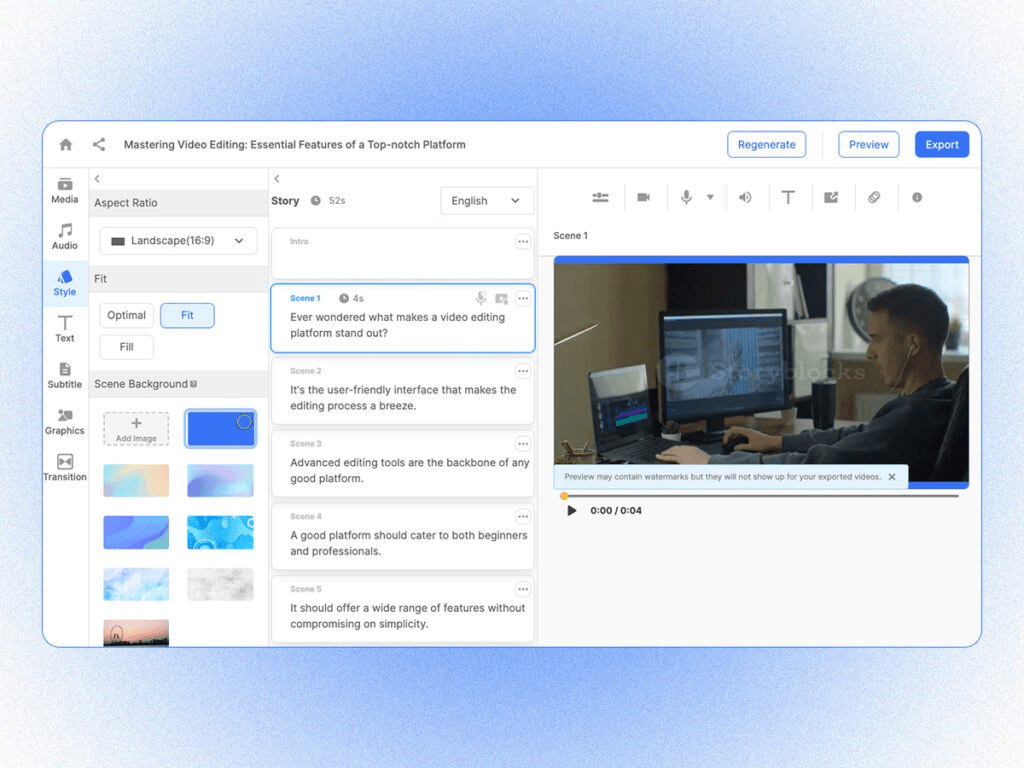What Are AI Video Generators?
AI video generators are advanced software tools that use artificial intelligence and machine learning techniques to automate various aspects of video creation. These tools analyze input data, such as text, images, audio, or existing video segments, and transform it into dynamic video presentations.
Current-generation video generators simplify the video creation process by automating tasks like editing, animation, and audio synchronization, making it easier for users to produce professional-quality videos much faster and without extensive technical expertise.
Next-generation video generators, many of which are still in development, take this one step further to create entire, production-quality videos from textual prompts.
In this article:
- How AI Video Generators Work
- Types of AI Video Generators
- Applications of AI Video Generators
- Current Generation vs Next-Generation AI Video Generators
- 10 Current-Generation AI Video Generators
How AI Video Generators Work {#how-ai-video-generators-work}
AI video generators operate by leveraging machine learning models trained on vast datasets of video and multimedia content. Here’s a step-by-step overview of the process:
- Data input: Users provide the necessary input data, which can be text, images, or audio. This input serves as the foundation for the video content.
- Content analysis: The AI system analyzes the input data to understand its context and extract key elements. For text, this might involve natural language processing (NLP) to identify important themes and messages. For images, computer vision techniques identify objects, faces, and relevant visual features. For audio, the system recognizes speech and sounds, converting them into text or identifying significant audio patterns.
- Content generation: Based on the analysis, the AI video generator selects suitable video clips, images, animations, and audio effects from its library or creates new ones. It organizes these elements into a coherent video sequence.
- **Editing and enhancement: **AI video tools typically support editing techniques such as adding text overlays, transitions, and special effects. It may also enhance the video quality by adjusting colors, brightness, and contrast, or by adding background music that fits the video’s tone.
- Preview and adjustment: Users can preview the generated video and make adjustments as needed. This step ensures that the final output meets their expectations and requirements.
- Final output: Once satisfied, users can export the video in their desired format and resolution, ready for distribution across various platforms.
Types of AI Video Generators {#types-of-ai-video-generators}
Text-to-Video Generators
Text-to-video generators transform written content into video sequences. They analyze the text to extract key points, which they then represent with matching images, video clips, and voice narration. Such generators can be used in media and education to convert articles, blogs, or scripts into more engaging and digestible video content.
These generators simplify content creation, making it accessible for users without video editing experience. Typically, users input text, select a theme or style, and the AI handles the rest, including transitions, animations, and even background music selection.
Learn more in our detailed guide to AI video generator from script (coming soon)
Image-to-Video Generators
Image-to-video generators create dynamic video content from static images. They can animate sequences of images, add transitions, and include overlaid text or music to enhance the viewing experience. They are useful for creating photo montages, event recaps, or product advertisements.
Using AI, these generators can identify the best order for presenting images, apply visually pleasing effects, and synchronize transitions with audio elements. This automation makes them suitable for professionals in digital marketing and social media.
Learn more in our detailed guide to AI video generator from image (coming soon)
Audio-to-Video Generators
Audio-to-video generators convert sound into visual mediums, suitable for podcasts, interviews, or music videos. By analyzing audio inputs, these systems synthesize corresponding visuals, such as waveforms, speaker animations, or illustrative graphics that reflect the audio content.
These generators can also synchronize lip movements in animated characters with spoken audio, enhancing the realism of animated educational videos or virtual presentations. This synchronization capability is useful for creating high-engagement content across various platforms.
Learn more in our detailed guide to AI video generator from audio (coming soon)
Applications of AI Video Generators {#applications-of-ai-video-generators}
AI video generators are often used across several industries:
- Social media and content creation: Creators and influencers use AI video generators to maintain a consistent stream of quality content. This reduces the time and effort required to create regular posts and updates, which aids in keeping audiences engaged and growing online communities.
- Marketing and advertising: They simplify the creation of promotional videos, enabling rapid assembly of content that can be customized to different audiences. This technology allows marketers to quickly adapt videos for various campaigns or platforms without significant additional cost or time.
- Entertainment: They are used to quickly produce teasers, pilot episodes, and promotional content for movies and TV shows, reducing production costs and time. This includes enabling personalized entertainment, modifying content based on viewer preferences and behaviors.
- Education and training: They can generate educational content, including instructional videos that are informative and engaging. They help convert complex topics into easily understandable visual formats, which enhance learning and retention.
Current Generation vs Next-Generation AI Video Generators {#current-generation-vs-next-generation-ai-video-generators}
Current-Generation Video Generators: Key Capabilities
AI video generators typically offer the following capabilities:
- Automated video creation: Automatically handle tasks that typically require manual input, such as editing, sequencing, and adding effects. They can transform raw input data into usable video content with minimal user intervention.
- High-quality video output: These tools can deliver videos with professional-grade visuals and audio, making them suitable for various applications, from corporate presentations to social media content. AI video generators use techniques such as noise reduction, color correction, and high-definition rendering to enhance video quality.
- Scene generation and animation: Generate scenes from textual descriptions, animate static images, and incorporate complex visual effects. This is especially useful for educational videos, explainer videos, and creative storytelling, where visual elements improve comprehension and engagement.
- Real-time editing and preview: Provide users with immediate feedback on their video edits, allowing for quick adjustments and refinements. This simplifies the editing process, enabling users to see the impact of changes as they make them. Real-time previews are useful for iterative content creation.
- Customizable templates: Offer a range of pre-designed video formats that cater to different content types and industries. These templates come with various styles, themes, and layouts, enabling users to create consistent and branded videos. Users can personalize templates by adding their own text, images, logos, and other branding elements.
Next-Generation Video Generators
Next-generation AI video generators further improve automated video creation by using more advanced machine learning models and generative AI techniques. These capabilities include:
- Text-to-video generation from simple prompts: Unlike current tools that require structured input, next-generation generators can create entire videos from simple, unstructured textual prompts. This allows users to describe a scene or concept in natural language, and the AI will generate corresponding video content with minimal user input.
- Contextual understanding and dynamic content creation: Have a deeper understanding of context, enabling them to create videos that are not just visually accurate but contextually relevant. This means the AI can generate videos that reflect the intended tone, style, and narrative flow based on the provided prompt, improving the overall coherence and quality of the output.
- Improved personalization and interactivity: Analyze user preferences, previous interactions, and external data to tailor videos to individual viewers or target audiences. This could include altering video content in real-time based on viewer feedback or interaction, making videos more engaging and interactive.
- Higher fidelity and realism in generated content: Achieve near-photorealistic quality in the videos they produce. This includes improvements in visual effects, such as more realistic lighting, shadows, and textures, as well as more lifelike animations and motion sequences.
- Scalability and efficiency for mass content production: Optimized for large-scale content production, capable of generating multiple video versions or entirely new videos based on slight variations in input data. This scalability is crucial for industries like marketing and entertainment, where there’s a need to produce a high volume of content quickly and cost-effectively.
10 Current-Generation AI Video Generators {#10-current-generation-ai-video-generators}
Synthesia
Synthesia is an AI video generation tool that produces talking head videos using photorealistic avatars. Users input a script, select from over 100 AI avatars, and the chosen avatar delivers the script as if speaking directly to the camera. However, the realism of these avatars may vary.
Source: Synthesia
Key Features of Synthesia
- Photorealistic Avatars: Choose from 160+ avatars, with options for customization.
- Video Templates: Access 60+ designer-created templates for various video formats.
- Multi-Language Support: Supports 120+ languages and 140+ voices and accents.
- Software Integrations: Integrates with tools like PowerPoint, WordPress, and LMS software.
- Custom Avatars: Create personalized avatars for unique branding.
Synthesia Pricing
- Starter: $22 per month, billed yearly. Includes one editor, three guests, 120 minutes of video per year, 70+ stock avatars, and one custom avatar.
- Creator: $67 per month, billed yearly. Offers one editor, five guests, 360 minutes of video per year, 90+ stock avatars, one custom avatar, custom fonts, and branded share pages.
- Enterprise: Contact for pricing. Provides a custom number of editors and guests, unlimited minutes of video, 140+ stock avatars, three custom avatars, translation and voice cloning, and additional support.
Pros and Cons of Synthesia
Pros:
- High-quality AI avatars
- Multi-language support with 120+ languages and 140+ voices
- Customizable design elements and templates
- Easy-to-use interface
Cons:
- Limited to talking head videos, reducing engagement options
- Avatars can appear less convincing on large screens
- Potential uncanny valley effect with some avatars
Colossyan
Colossyan is an AI-powered video generator that creates videos from text inputs, incorporating AI actors to enhance the content. It is particularly useful for learning and training videos, explainer videos, corporate communications, and marketing. Users can select from a range of pre-designed AI actors, customize their emotions and age, and adjust the video’s aspect ratio to fit different platforms.
Source: Colossyan
Key Features of Colossyan
- 70+ Languages: Colossyan supports over 70 voices and accents, facilitating diverse and inclusive content creation.
- 30+ AI Actors: Offers a variety of AI avatars, with options to customize their appearance and emotions.
- Multiple Actors in One Scene: Users can incorporate multiple AI actors in a single video, enhancing the narrative complexity.
- Emotions and Age Adjustment: Enterprise clients can adjust the age and emotions of AI actors, adding depth to the content.
- Aspect Ratio Resizing: Allows videos to be resized to fit different aspect ratios, ensuring compatibility with various platforms.
Colossyan Pricing
- Free Demo: Provides 5 minutes of video with a watermark.
- Basic Plan: Starts at $21 per month for 10 minutes of video.
- Pro Plan: Begins at $100 per month for 40 minutes of video.
- Enterprise Plan: Offers custom pricing with all features available.
- Custom Avatars: For $1000/year, users can create their custom avatars, tailoring the video to their specific branding needs.
Pros and Cons of Colossyan
Pros:
- Automated video translation
- Multiple aspect ratios for versatile video formats
- User-friendly interface
- Flexible pricing plans
Cons:
- Lip-syncing may appear unnatural
- Limited avatar diversity
- Occasional errors requiring a page refresh
Runway
Runway is an AI-powered video editing tool that provides users with a range of generative AI features. While it requires some learning to master, it offers capabilities for creating and editing video content. Runway operates through a set of AI tools that enhance video editing and generation with features such as text-to-video, green screen, and object removal.
Source: Runway
Key Features of Runway
- Text-to-Video Feature: Allows users to generate videos by describing scenes in text.
- Automatic Prompt Suggestions: Provides helpful prompts to guide video creation.
- Image Upload for Reference: Users can upload images to influence the generated video.
- Multiple Previews: Offers different preview options before finalizing the video.
- Free Plan: A free plan is available to test the tool with basic features and limited credits.
Runway Pricing
- Basic Plan: Free, includes 125 credits and limited AI tools.
- Standard Plan: $12 per month, offers 625 credits.
- Pro Plan: $28 per month, includes 2250 credits.
- Unlimited Plan: $76 per month, offers unlimited video generation.
- Enterprise Plan: Custom pricing for advanced needs.
Pros and Cons of Runway
Pros:
- Comprehensive set of AI tools for unique video editing.
- Excellent tutorial content to aid learning.
- Available on both desktop and mobile platforms.
Cons:
- Steep learning curve requiring time investment.
- The gen-2 feature has limitations with intricate details.
- Lacks text-to-speech capabilities.
DeepBrain AI
DeepBrain AI can simplify the process of creating AI-generated videos using basic text inputs. It caters to beginners by providing a platform that saves time and cost in video production. DeepBrain AI transforms written scripts into video content featuring AI avatars. Users can input text, which the platform then converts into a video using realistic text-to-speech voices.
Source: DeepBrain
Key Features of DeepBrain AI
- Text-to-Video Generation: Converts text scripts into video content with AI avatars.
- Text-to-Speech: Offers realistic AI voices in over 80 languages.
- ChatGPT Integration: Helps generate scripts for videos, enhancing ease of use.
- Customizable Avatars: Users can develop custom AI avatars for personalized content.
- 2D/3D Conversational AI Humans: Provides both 2D and 3D AI avatars for more engaging interactions.
DeepBrain AI Pricing
- Starter Plan: $24 per month (billed annually), includes 10 minutes of video per month, with a maximum of 10 minutes per video and up to 6 scenes per video.
- Pro Plan: $180 per month (billed annually), offers 90 minutes of video per month, with a maximum of 20 minutes per video and up to 25 scenes per video.
- Enterprise Plan: Custom pricing based on specific requirements, includes up to 50 scenes per video and custom avatars.
Pros and Cons of DeepBrain AI
Pros:
- Cost-effective video creation
- No need for users to be on camera
- Integration with ChatGPT for scriptwriting
- Realistic text-to-speech voices
Cons:
- Avatars can appear robotic and lack realism
- Fewer avatar choices compared to competitors
- Limited advanced video editing features
- Requires more tutorials for better user onboarding
Descript
Descript transcribes audio and video files into text for simplified editing. It caters to a variety of use cases including podcasting, TikTok, YouTube videos, marketing, sales, and learning and development. This tool enables users to edit their content by editing the transcribed text.
Source: Descript
Key Features of Descript
- Text-Based Editing: Edit videos by modifying the transcript, simplifying the editing process for users more comfortable with text.
- Filler Word Removal: Automatically removes filler words such as “ums” to streamline audio.
- Voice Cloning: Allows users to clone their voice using AI, providing a unique tool for content creators.
- Multi-Track Editing: Supports editing multiple tracks, enhancing its utility for complex projects.
- Collaborative Tools: Enables collaboration among team members, making it a practical solution for businesses.
- Seamless Integrations: Integrates with popular platforms for easy content management and distribution.
- Intuitive Interface: Helps save time with an easy-to-use interface and efficient workflow.
Descript Pricing
- Free: Offers 1 transcription hour per month, limited features including one watermark-free video export per month, and access to tools like filler word removal, green screen, AI voices, and a stock library.
- Creator: Priced at $12 per user per month (billed annually), it includes 10 transcription hours per month for each editor, unlimited watermark-free video exports, and increased tool access.
- Pro: Costs $24 per user per month (billed annually), providing 30 transcription hours per month for each editor and unlimited access to most tools.
- Enterprise: Custom pricing with all Pro package features plus dedicated support and onboarding.
Pros and Cons of Descript
Pros:
- Intuitive controls and user-friendly interface.
- Efficient editing through text-based modifications.
- Time-saving automation and integrations.
Cons:
- Occasional transcription inaccuracies.
- Potential app crashes during editing sessions.
Peech
Peech is an AI-driven video creation tool that can simplify and accelerate the video production process, particularly for marketing teams. It offers an intuitive workflow and customizable design elements, making it easy to produce branded video content quickly. Peech allows users to upload their brand kit, including logos and color schemes, which it then applies automatically to all videos.
Source: Peech
Key Features of Peech
- Intuitive Workflow: Easy-to-use interface that simplifies video creation.
- Customizable Design Elements: Automatically applies brand assets like logos and colors to videos.
- Face Detection: Identifies faces in videos and adds name and role cards.
- Customizable Subtitles: Allows for highlighting text with brand colors.
- Aspect Ratio and Length Adjustment: Quick selection of video dimensions and durations.
- First Draft Optimization: Generates a near-final draft, reducing the need for extensive editing.
Peech Products
- Peech Lite: Core product that requires adding brand kits and automates the branding of videos.
- Peech Webinars: Upload webinars, highlight segments, and export as short, branded videos.
- Peech Testimonials: Simplifies creating video testimonials by inviting clients to record reviews, which are then automatically branded and subtitled.
Peech Pricing
- Free Plan: Available for 1 user, allows 2 videos per month, 5-minute upload limit, and includes a watermark.
- Pro Plan: Starts at $59 per month, allows 10 videos per month, 50-minute upload limit, and removes the watermark.
- Creator Plan: $99 per month, offers 10 edited video downloads with watermark per month, a 60-minute upload max per video, for one user.
- Enterprise Plan: Custom pricing with unlimited downloads (no watermark), up to 90-minute upload max per video, and multiple users.
Pros and Cons of Peech
Pros:
- Intuitive workflow
- Customizable design for video elements
- Efficient segmentation and repurposing of video content
- Automated addition of music and subtitles
Cons:
- Steep pricing
- Limited to marketing, advertising, and social media use cases
- Automation may limit detailed editing capabilities
- Limited video segmenting features
Pictory
Pictory is an AI-powered video generator that can transform lengthy text-based content into engaging, branded videos. By providing a link to a blog post, article, or text document, Pictory automatically curates scenes and pairs them with a library of stock content, creating compelling videos. Users can add their brand elements and customize the visual style.
Source: Pictory
Key Features of Pictory
- Support for Different Aspect Ratios: Create videos in various aspect ratios to suit different platforms.
- Extensive Template Library: Choose from a wide range of templates to simplify video creation.
- Automatic Captions: Add captions to videos automatically, enhancing accessibility and engagement.
- Stock Assets: Access a vast library of stock images, music, and videos to enrich your content.
- Text-to-Speech: Convert text into voiceovers using a selection of voices, currently supporting English only.
Pictory Pricing
- Free Trial: Create three video projects, with a maximum of ten minutes per video.
- Starter: $19 per month (billed yearly). Includes 30 videos per month, 600 transcription minutes, royalty-free assets, and 34 AI voices in seven languages.
- Professional: $39 per month (billed yearly). Offers 60 videos per month, 1,200 transcription minutes, additional voices, and more royalty-free assets.
- Teams: $99 per month (billed yearly). For three users, includes 90 videos per month, 1,200 transcription minutes, additional branding kits, sharing and collaboration features, and API access.
Pros and Cons of Pictory
Pros:
- User-friendly interface for non-technical users
- Extensive library of templates, images, and music
- Automatic addition of subtitles and captions
- Efficiently transforms long-form content into short videos
Cons:
- No AI avatars or characters
- Limited to English for voiceovers
- Voices may sound robotic to some users
- Occasional issues with audio synchronization
InVideo
InVideo is an AI-powered video creation tool that simplifies the video production process. It offers a library of ready-made templates categorized by business, social media, advertisement, real estate, and more. InVideo’s automated script-to-video capabilities and quick editing tools make it accessible for non-technical users to produce high-quality videos.
Source: InVideo
Key Features of InVideo
- Extensive Template Library: Offers over 5,000 customizable templates organized by categories such as business, intro/outro, slideshow, and social media.
- Automated Script-to-Video: Transforms text scripts into video scenes with relevant visuals and animations.
- User-Friendly Interface: Simple and intuitive, designed for users with varying levels of video editing experience.
- Quick Editing Tools: Allows users to trim, cut, rotate, compress, and convert video files easily.
- AI Avatars and Voiceovers: Select from preset AI avatars or build your own; supports various languages for AI voiceovers.
InVideo Pricing
- Free Plan: Includes limited features, 15 minutes max per video, and watermarked exports.
- Business Plan: $15 per month. Access to premium templates, 60 video exports per month, 40 minutes max per video, and 10 media assets from the iStock library per month.
- Unlimited Plan: $30 per month. Unlimited video exports per month, 40 minutes max per video, and 120 media assets from the iStock library per month.
Pros and Cons of InVideo
Pros:
- User-friendly, prompt-based interface
- Extensive template library for various use cases
- AI avatars and automated script-to-video conversion
- Collaboration features for remote teams
- Large collection of royalty-free media
Cons:
- Extensive template library can be difficult to search
- Limited customization options for templates
- Priority support only for paid subscribers
- Long rendering times for extended videos
Fliki
Fliki combines text-to-video and text-to-speech AI capabilities, enabling users to create videos as quickly as they can write text. It caters to various content creation needs, from educational videos to social media content. However, unlike other AI video generators, Fliki does not offer AI avatars. Fliki converts written text into video content by using its library of text-to-speech voices and stock assets.
Source: Fliki
Key Features of Fliki
- Extensive Language and Voice Support: Over 2,000 voices in 75+ languages and 100+ dialects.
- Beginner-Friendly Interface: Simplifies content creation for users with no video editing experience.
- Text-to-Speech and Text-to-Video Conversion: Converts text scripts into videos with realistic voiceovers.
- Integrated Stock Library: Includes royalty-free images, music, and videos from Pixabay.
- Voice Customization: Adjust tone, pitch, and pauses to create the desired voiceover effect.
Fliki Pricing
- Free Plan: Includes 5 minutes of video credits per month with watermarked, 720p resolution videos.
- Standard Plan: $28 per month. Offers 180 minutes of video credits per month, removes the watermark, and provides 1080p video quality.
- Premium Plan: $88 per month. Includes 600 minutes of video credits per month, longer videos, and advanced features like voice cloning and AI avatars.
Pros and Cons of Fliki
Pros:
- Versatile use cases, from YouTube videos to blog conversions
- Extensive stock library integrated with Pixabay
- Wide variety of voice styles and emotions for enhanced storytelling
- Simple and effective text-to-speech intonation controls
- Quick video creation ready for social media
Cons:
- No AI avatars
- Text-to-speech voices for regional dialects may sound similar
- Limited customization options for branding
- Occasional performance issues and bugs
- Video quality may not always meet professional standards
Visla
Visla is an AI-driven video creation tool that simplifies the process of generating and editing videos. It can generate text scripts and accurately match stock images and videos to the script content, making it suitable for users who need to produce high-quality videos. Visla allows users to create video content without needing a pre-written script.
Source: Visla
Key Features of Visla
- Script Generation: Creates concise video scripts with short paragraphs.
- Accurate Stock Suggestions: AI engine matches stock images and videos to script content.
- Direct Recording: Record video directly into the platform, with teleprompter support.
- AI Editing: Removes filler words and hesitations from recordings.
- Text-Based Video Editing: Similar to Descript, allows for easy off-topic content removal.
- Meeting Assistant: Records video meetings and extracts snippets for sharing.
Pros and Cons of Visla
Pros:
- Good text script generation
- Accurate AI video stock suggestions
- Direct recording with teleprompter support
- AI editing for removing filler words and hesitations
- Meeting assistant functionality for recording and sharing snippets
Cons:
- Limited help and guides available
- Does not offer extensive customization options
Related content: Read our guide to AI video generation tools (coming soon)
Build AI Video Generation with Acorn
Visit https://gptscript.ai to download GPTScript and start building today. Check out this tutorial on using GPTScript to build
an AI-powered YouTube title and thumbnail generator. As we expand on the capabilities with GPTScript, we are also expanding our list of tools. With these tools, you can create any application imaginable: check out tools.gptscript.ai to get started.

